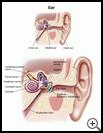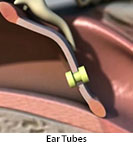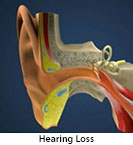
Earache
________________________________________________________________________
KEY POINTS
- An earache is pain inside or around the ear. Earaches are common in children.
- Ear pain is usually treated with nonprescription pain medicine. Your child’s healthcare provider may prescribe antibiotics for an ear infection, though most children with an ear infection do not need antibiotics.
- Follow your child’s healthcare provider's instructions for care. Ask your provider what symptoms or problems you should watch for and what to do if your child has them.
________________________________________________________________________
What is an earache?
An earache is pain inside or around the ear. Earaches are common in children.
What is the cause?
Common causes include:
- Infections
Your child may get a cold and the infection may spread to the middle ear. The tube between the middle ear and throat may swell. The swelling traps fluid, which can cause pain.
The ear canal, or outer ear, can also get infected and cause pain. This usually happens during the summer when children have been swimming.
- Injury
Small objects placed in the ear, such as toys or cotton swabs, may hurt the ear.
- Pressure
Different types of pressure can cause an earache.
- Earwax may form a blockage in the ear canal and cause pressure in the ear.
- Decreases in air pressure, such as when your child flies in an airplane or goes to the mountains, can also cause pain. This happens because the pressure in the middle ear is greater than the outside air pressure at high altitudes.
Children sometimes say their ear hurts when the pain is actually in another place. The pain may be caused by an infected or decayed tooth or an infection of the scalp, neck, throat, or sinuses.
What are the symptoms?
When your child has an earache, he or she may:
- Complain of pain in the ear, cry, be irritable, or have trouble sleeping
- Have drainage of fluid from the ear
- Have a temporary loss of hearing
- Have a fever
Very young children may rub or pull at the ear.
How is it diagnosed?
Your healthcare provider will ask about your child’s symptoms and medical history and examine your child. Your provider will examine your child's ears with a special scope.
How is it treated?
Ear pain is usually treated with nonprescription pain medicine.
In some cases, your provider may prescribe antibiotics for an ear infection. However, ear infections often get better in a few days without antibiotics. Most children with an ear infection do not need antibiotics.
Infections of the ear canal are often treated with antibiotic drops, which may also contain medicine for pain.
Wax or objects blocking the ear canal should be removed by your healthcare provider.
How can I take care of my child?
Follow your healthcare provider's instructions for care.
To help relieve pain you can put a warm moist washcloth or a hot water bottle covered with a towel over the ear.
Ask your provider:
- How long it will take your child to recover from this illness
- If there are activities your child should avoid and when your child can return to normal activities
- How to take care of your child at home
- What symptoms or problems you should watch for and what to do if your child has them
Make sure you know if or when your child should come back for a checkup.
If your child has problems with earwax, you can put 1 to 2 drops of mineral or vegetable oil into the ear canal for a few minutes each day. Wipe away any oil that drips out from the ear. You can start doing this just once a week or less often when your child has less pain or stuffiness in the ear or seems to be hearing better. There are many nonprescription drops that may be helpful as well. Never try to clean the ear canal with cotton swabs or other things. They could push the wax down further or damage the ear.
If your child's ears hurt from changes in air pressure, you can help your child learn how to relieve the pressure by chewing and swallowing. This opens the tube from the throat to the middle ear. Teach older children to close their mouth, pinch their nose, and gently blow air out. This will often make their ears feel like they "pop." For babies, you can help by nursing or feeding your child when you are changing altitude, such as during takeoff or landing in a plane. This makes your child swallow, which helps balance the air pressure.
Last modified: 2017-11-15
Last reviewed: 2017-11-15



